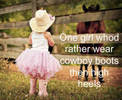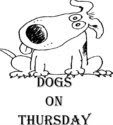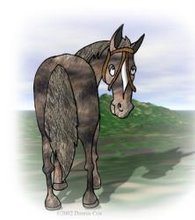Grapes and Raisins. These contain an unknown substance which can cause acute renal failure in some dogs. Even a handful could cause death. Dogs have died after ingesting 0.41 to 1.1 ounces per kilogram of body weight. (1 kg = 2.2 lbs.) Early symptoms include vomiting and diarrhea, followed by signs of kidney failure starting about 24 hours after ingestion, which may not be noticeable for the first 3 to 5 days. If you notice your dog ingested grapes or raisins, seek treatment immediately. It is unknown why some dogs seem not to be affected at all, while others react to a small amount and die. "Grapeseed extract" is safe for dogs, and is used in dog foods as a rich source of powerful antioxidants called proanthocyanidins.
Chocolate and Cocoa. Theobromine is a methylxanthine compound similar to caffeine, but only 25% as effective as a stimulant for humans. Both can be fatal to dogs and birds. Do not let your dog ingest types of chocolate that contain the highest levels of Theobromine, which are pure cocoa powder, baker's chocolate, and dark chocolate (in that order), since ingesting even smaller quantities may be toxic. Just two ounces of baker's chocolate can kill a small dog! Be aware that cocoa bean mulch used in gardens may get eaten by dogs, and it also contains high levels of Theobromine (300 to 1200 mg per ounce). Ingesting over 9 ounces can kill a 50 pound dog. Early symptoms of chocolate toxicity are: hyperactivity, sudden excitement or "manic" type of behavior, muscle tremors, rapid heart rate, and increased urination - similar to an overdose of caffeine in humans. If chocolate or caffeine ingestion was observed, inducing vomiting within two hours may help. Get veterinary treatment IMMEDIATELY, for ingesting a high dose can cause death within 12 hours. See more details below.
Caffeine. Ingesting caffeine raises a dog's heart rate to a dangerous level, and has been known to cause seizures, and sometimes death. Early symptoms of caffeine ingestion occur quickly and include: hyperactivity or excitement, rapid heart rate, muscle tremors, and increased urination. Note that coffee beans, instant coffee powder, coffee grounds, guarano beans, tea, "energy" drinks, weight loss pills, colas and many clear and colored soft drinks contain high levels of caffeine which can affect a dog's central nervous system and heart. (Colas and soft drinks also contain way too much sugar, which could cause pancreatitis, or could contain Xylitol which is also toxic to dogs.)
Later symptoms of caffeine ingestion are: vomiting, restlessness or hyperactivity, muscle tremors, heart palpitations, and even death. Give lots of water and take your dog to the vet immediately. Note that both caffeine and nicotine are narcotic drugs which affect the brain and nervous system, and less than a drop of pure nicotine or caffeine could kill a large human or dog as quickly as a heroin overdose.
Nicotine and Tobacco. Nicotine found in cigarettes and cigars or their butts, pipe tobacco, chewing tobacco, nicotine patches, and nicotine gum can be fatal to dogs, cats, birds - and human babies - if they are eaten. Early symptoms of nicotine ingestion may appear within an hour, and include: hyperactivity, salivation, panting, vomiting, and diarrhea. Advanced symptoms include: rapid heart rate, muscle tremors or twitching, muscle weakness, collapse, coma, and cardiac arrest. Give lots of water and take your pet to the vet immediately.
Alcohol. When a dog ingests alcohol it can cause disorientation and lead to injury, sickness, urination problems, or even coma or death from alcohol poisoning. Just one ounce can sometimes be lethal. Alcohol is present in beer, ale, hard cider, wine, liquor, spirits, liqueurs, vodka or rum "cooler" drinks, vanilla extract, and some herbal tinctures. "Denatured" alcohol used to fuel fondue and food warmers is a deadly poison to dogs, cats and humans.
Nutmeg. This is a brownish spice often used in eggnog and mulled cider. It affects the central nervous system of dogs and may cause tremors or seizures. If larger amounts of nutmeg are ingested it can cause death (in humans too).
Raw Salmon and Trout. These two tasty fish can be infected with a parasite called Nanophyetus salmincola, a type of trematode worm which itself is often infected with a type of bacteria known as Neorickettsia helminthoeca that only affects canines, not other animals. Dogs can show symptoms such as: weakness, loss of appetite, vomiting, swollen glands, and fever - and 90% of untreated dogs die. Thorough cooking kills the both the worm and the bacteria. Note that sushi may contain raw salmon.
Raw Eggs. RAW chicken and chicken eggs can be infected with Salmonella bacteria which cause food poisoning in dogs and humans, and cats are the most susceptible. Symptoms of Salmonella poisoning include: fever, diarrhea, bloody diarrhea, nausea, vomiting, and abdominal pain. Egg yolks are generally safe, but raw egg whites contain a protein called avidin which can deplete your dog of biotin, one of the B vitamins (though some research indicates that it would take large quantities of egg whites to cause this condition). Symptoms of biotin depletion are: weakness, hair loss, retarded growth, and deformity of the skeleton.
However, cooked eggs are safe, very nutritious, and make a fine doggie treat. Thorough cooking at a temperature above 180 degrees Fahrenheit kills Salmonella bacteria and destroys its toxin, so hard-boiled eggs make a safe and healthy dog treat.
Peanuts and Sunflower Seeds. These, and peanut butter, are not normally toxic. But the sunflower seeds or peanuts and particularly the hulls are too often contaminated with Aspergillus fungus mold that produces Aflatoxin which can cause liver damage and death for dogs, the mammal most sensitive to Aflatoxin poisoning. Field corn and wheat are also very frequent hosts for this toxic mold that is especially deadly to dogs and birds.
Levels of Aflatoxin too low to harm pigs or people can be fatal to dogs and birds, who are the MOST sensitive to it. Even the U.S. FDA "acceptable" concentration of aflatoxin contamination in peanuts fit for humans - a maximum of 20 ppb - may not protect your dog. Note that cooking can kill the fungus, but will NOT deactivate any of the poisonous aflatoxin which it may have already produced. Thus feeding sunflower seeds, peanuts or peanut hulls to a dog may seem too much of a risk for Aflatoxin Poisoning.
Moldy foods. If it's a mold like Aspergillus which produced aflatoxin it can be severely toxic or fatal to dogs.
Cooked Chicken Bones. Raw chicken bones are flexible and not usually a problem, but when cooked they get brittle and can splinter into sharp little daggers that tear your dog's throat or intestines. Some other types of cooked bones like ham, pork chop, pork ribs, and veal can also get brittle and may pose a danger to your dog. Feeding RAW, uncooked bones like chicken necks and beef knuckles are the safest choice, and may help clean plaque from your dog's teeth. Rawhide "bones" sometimes cause choking when hard pieces break off, so keep an eye on your dog while he chews them.
Corn Cobs when swallowed in chunks can lodge in your dog's throat or intestines, with sometimes fatal results. Do NOT feed your dog corn on the cob or allow access to corn cobs. Also note that dogs cannot digest corn, and it may cause a food allergy. Corn is also a frequent host for the white fungal mold that produces aflatoxin which is deadly to dogs.
Chocolate and Cocoa. Theobromine is a methylxanthine compound similar to caffeine, but only 25% as effective as a stimulant for humans. Both can be fatal to dogs and birds. Do not let your dog ingest types of chocolate that contain the highest levels of Theobromine, which are pure cocoa powder, baker's chocolate, and dark chocolate (in that order), since ingesting even smaller quantities may be toxic. Just two ounces of baker's chocolate can kill a small dog! Be aware that cocoa bean mulch used in gardens may get eaten by dogs, and it also contains high levels of Theobromine (300 to 1200 mg per ounce). Ingesting over 9 ounces can kill a 50 pound dog. Early symptoms of chocolate toxicity are: hyperactivity, sudden excitement or "manic" type of behavior, muscle tremors, rapid heart rate, and increased urination - similar to an overdose of caffeine in humans. If chocolate or caffeine ingestion was observed, inducing vomiting within two hours may help. Get veterinary treatment IMMEDIATELY, for ingesting a high dose can cause death within 12 hours. See more details below.
Caffeine. Ingesting caffeine raises a dog's heart rate to a dangerous level, and has been known to cause seizures, and sometimes death. Early symptoms of caffeine ingestion occur quickly and include: hyperactivity or excitement, rapid heart rate, muscle tremors, and increased urination. Note that coffee beans, instant coffee powder, coffee grounds, guarano beans, tea, "energy" drinks, weight loss pills, colas and many clear and colored soft drinks contain high levels of caffeine which can affect a dog's central nervous system and heart. (Colas and soft drinks also contain way too much sugar, which could cause pancreatitis, or could contain Xylitol which is also toxic to dogs.)
Later symptoms of caffeine ingestion are: vomiting, restlessness or hyperactivity, muscle tremors, heart palpitations, and even death. Give lots of water and take your dog to the vet immediately. Note that both caffeine and nicotine are narcotic drugs which affect the brain and nervous system, and less than a drop of pure nicotine or caffeine could kill a large human or dog as quickly as a heroin overdose.
Nicotine and Tobacco. Nicotine found in cigarettes and cigars or their butts, pipe tobacco, chewing tobacco, nicotine patches, and nicotine gum can be fatal to dogs, cats, birds - and human babies - if they are eaten. Early symptoms of nicotine ingestion may appear within an hour, and include: hyperactivity, salivation, panting, vomiting, and diarrhea. Advanced symptoms include: rapid heart rate, muscle tremors or twitching, muscle weakness, collapse, coma, and cardiac arrest. Give lots of water and take your pet to the vet immediately.
Alcohol. When a dog ingests alcohol it can cause disorientation and lead to injury, sickness, urination problems, or even coma or death from alcohol poisoning. Just one ounce can sometimes be lethal. Alcohol is present in beer, ale, hard cider, wine, liquor, spirits, liqueurs, vodka or rum "cooler" drinks, vanilla extract, and some herbal tinctures. "Denatured" alcohol used to fuel fondue and food warmers is a deadly poison to dogs, cats and humans.
Nutmeg. This is a brownish spice often used in eggnog and mulled cider. It affects the central nervous system of dogs and may cause tremors or seizures. If larger amounts of nutmeg are ingested it can cause death (in humans too).
Raw Salmon and Trout. These two tasty fish can be infected with a parasite called Nanophyetus salmincola, a type of trematode worm which itself is often infected with a type of bacteria known as Neorickettsia helminthoeca that only affects canines, not other animals. Dogs can show symptoms such as: weakness, loss of appetite, vomiting, swollen glands, and fever - and 90% of untreated dogs die. Thorough cooking kills the both the worm and the bacteria. Note that sushi may contain raw salmon.
Raw Eggs. RAW chicken and chicken eggs can be infected with Salmonella bacteria which cause food poisoning in dogs and humans, and cats are the most susceptible. Symptoms of Salmonella poisoning include: fever, diarrhea, bloody diarrhea, nausea, vomiting, and abdominal pain. Egg yolks are generally safe, but raw egg whites contain a protein called avidin which can deplete your dog of biotin, one of the B vitamins (though some research indicates that it would take large quantities of egg whites to cause this condition). Symptoms of biotin depletion are: weakness, hair loss, retarded growth, and deformity of the skeleton.
However, cooked eggs are safe, very nutritious, and make a fine doggie treat. Thorough cooking at a temperature above 180 degrees Fahrenheit kills Salmonella bacteria and destroys its toxin, so hard-boiled eggs make a safe and healthy dog treat.
Peanuts and Sunflower Seeds. These, and peanut butter, are not normally toxic. But the sunflower seeds or peanuts and particularly the hulls are too often contaminated with Aspergillus fungus mold that produces Aflatoxin which can cause liver damage and death for dogs, the mammal most sensitive to Aflatoxin poisoning. Field corn and wheat are also very frequent hosts for this toxic mold that is especially deadly to dogs and birds.
Levels of Aflatoxin too low to harm pigs or people can be fatal to dogs and birds, who are the MOST sensitive to it. Even the U.S. FDA "acceptable" concentration of aflatoxin contamination in peanuts fit for humans - a maximum of 20 ppb - may not protect your dog. Note that cooking can kill the fungus, but will NOT deactivate any of the poisonous aflatoxin which it may have already produced. Thus feeding sunflower seeds, peanuts or peanut hulls to a dog may seem too much of a risk for Aflatoxin Poisoning.
Moldy foods. If it's a mold like Aspergillus which produced aflatoxin it can be severely toxic or fatal to dogs.
Cooked Chicken Bones. Raw chicken bones are flexible and not usually a problem, but when cooked they get brittle and can splinter into sharp little daggers that tear your dog's throat or intestines. Some other types of cooked bones like ham, pork chop, pork ribs, and veal can also get brittle and may pose a danger to your dog. Feeding RAW, uncooked bones like chicken necks and beef knuckles are the safest choice, and may help clean plaque from your dog's teeth. Rawhide "bones" sometimes cause choking when hard pieces break off, so keep an eye on your dog while he chews them.
Corn Cobs when swallowed in chunks can lodge in your dog's throat or intestines, with sometimes fatal results. Do NOT feed your dog corn on the cob or allow access to corn cobs. Also note that dogs cannot digest corn, and it may cause a food allergy. Corn is also a frequent host for the white fungal mold that produces aflatoxin which is deadly to dogs.
Raw Bread Dough and Bread-making Yeast. The yeast which causes bread and pizza dough to rise will ferment and expand and produce alcohol in a dog's warm stomach, which can cause alcohol poisoning, disorientation, discomfort, vomiting or unsuccessful attempts at vomiting, bloating, and even rupture of the intestines - even in small amounts, since the raw dough expands to many times its original size. Small dogs are most at risk. If a large amount was eaten or you see the stomach swells significantly - a condition called "bloat" - EMERGENCY TREATMENT is necessary. Do not waste time! Get your dog to the vet right away, because bloat can quickly cause serious problems and even lead to death. See more on "bloat" below. ("Brewers Yeast" is different than baking yeast, and is a safe nutritional supplement.)
Raw Cookie Dough or Cake Mix. The baking powder which creates carbon dioxide gas bubbles to expand the cookie or cake mix can create gas in the warm stomach and intestines of a dog which eats the unbaked mix. The expansion of the raw mixture can cause flatulence, discomfort, and bloating. Ingesting large amounts could possibly cause a rupture of the intestines, so in this case, inducing vomiting as soon as possible may help. If significant swelling of the stomach or "bloat" has occurred, take your dog for emergency treatment IMMEDIATELY!
Fruit pips. The seeds, stems, and leaves of apples, apricots, cherries, peaches, pears and plums all contain cyanogenic glycosides - which can produce cyanide poison when metabolized in the dog's body. While these glycosides are not harmful to humans, some have the potential to cause vomiting and loss of appetite in dogs and cats. Ingesting large amounts can cause these symptoms: dilated pupils, difficulty breathing, hyperventilation, weakness, staggering - or even shock, coma, and death. The flesh or pulp of these fruits is not toxic and can safely be fed to a dog.
Apple Seeds, Stems and Leaves. See Fruit pips above. The flesh of the apple fruit is safe, and many dogs love to eat apples. Just remove the toxic stem and pips. Keep stored apples out of reach of your dog, who may eat the whole apple with stems and seeds.
Potatoes. The starchy white flesh inside raw or cooked potatoes is not harmful, but potato skins which are still green and any green sprouts or "eyes" contain the alkaloid solanum which is poisonous to dogs and humans. You should store raw potatoes out of reach of your dog, for they often grow little green sprouts which are toxic if the dog eats them. And don't let your dog get at potato peelings from the garbage bin.
Avocado. The fruit, leaves, and bark contain a toxic compound called persin - especially in the skins - which can damage the heart, lung and other tissues of a dog. If larger quantities are ingested, the high fat content of avocado fruit can trigger vomiting or even lead to pancreatitis, so keep your dog away from guacamole dip made from avocado. Symptoms of avocado ingestion include: difficulty breathing, enlarged abdomen, and abnormal fluid accumulations in the chest and abdomen and around the heart. The hard pit inside is also toxic, and can cause choking or intestinal blockage if swallowed.
Mushrooms. The mushrooms normally eaten by humans are safe, but feeding mushrooms to your dog might encourage your pet to eat wild mushrooms which may be poisonous enough to cause sickness or even death. If your dog goes outside, you should remove all wild mushrooms in your yard, and don't let him eat any mushrooms he may encounter while on a walk or hike with you.
Milk & Dairy Products. About 50% of dogs, like some humans, are lactose intolerant, i.e. unable to digest Lactose, which is also called "milk sugar". Their bodies do not produce the enzyme lactase which can break down lactose. This can cause stomach cramps, gas, foul smelling excrement, and diarrhea. Cheese, cottage cheese, and plain yogurt (with no sugar added) contain less lactose, so most dogs can tolerate small amounts of these dairy foods which many dogs love as a treat. Note that cow milk is quite often contaminated with aflatoxin produced by Aspergillus mold, but at very low levels considered safe for humans. Yet that level may be unsafe for canines, who are MUCH more sensitive to this poison than any other mammals.
Onions and Garlic. In dogs, cats and other mammals, ingesting large quantities at once or the continual consumption of raw onions, garlic, chives and leeks (members of the Allium family) which contain thiosulphate, can cause red blood cells to rupture and result in Heinz-Body Hemolytic Anemia. Ingesting 2.5 grams of dehydrated onions per pound of body weight causes hemolysis and anemia in dogs, especially in Akitas and Japanese Simbas. Small puppies have died of hemolytic anemia after being fed human baby food containing onion powder, and it can make kittens sick. Garlic has a lesser effect than onions, and only larger amounts of garlic cause problems. To stop eating onions and garlic can reverse the anemia.
Baby Food. Do not feed human baby food to puppies, especially if the formula contains onion powder or certain vegetables in this list. Refer to "Onions and Garlic" above.
Broccoli. This vegetable is nutritious for dogs in small amounts, but if the amount exceeds about ten percent of their daily food intake the substance isothiocyanate can cause gastrointestinal irritation.
Tomatoes and Rhubarb. The stems and leaves contain oxalates, which can cause bladder stones.
Xylitol. This natural-source sweetener is often used in sugar-free candy and gum. Eating large amounts can cause a drop in blood sugar for dogs - but not humans - which can lead to weakness, staggering, and other symptoms of hypoglycemia). A sudden drop in blood sugar could result in loss of coordination and seizures, sometimes less than 30 minutes after your dog ingests enough Xylitol.
Macadamia Nuts. Eating as little as six nuts can cause elevated body temperature, accelerated heartbeat, anxiety, weakness, muscle tremors, and paralysis of the hindquarters of a dog, which usually ends in a few days. The cause is not known.
Walnuts. Eating walnuts can cause gastroenteritis in dogs
All tree nuts. These nuts contain high levels of phosphorus which can lead to the formation of bladder stones in dogs. Tree nuts like Brazil nuts, pecans, pistachios, and walnuts sold for human consumption are often contaminated with very low levels of poisonous aflatoxin from Aspergillus mold which the U.S. FDA considers safe for humans. Yet that same low concentration may be toxic to dogs and birds, which are the animals MOST sensitive to this poison.
Turkey Skin or Ham Fat. Any high-fat meal can cause acute pancreatitis in dogs that have a fixed diet like commercial dog food and are not used to high-fat foods like these. Symptoms of pancreatitis include vomiting and pain in stomach. Emergency treatment is needed.
Liver. Eating this animal organ is safe and nutritious in small amounts. But it contains high levels of Vitamin A, and ingesting large amounts or feeding liver to a dog already receiving Vitamin A supplements can lead to Vitamin A toxicity (hypervitaminosis A). Feeding your dog three servings of raw or cooked liver a week could lead to bone problems. Symptoms of hypervitaminosis A are: weight loss, anorexia, deformed bones, and excessive bone growth on the hocks and spine. If untreated, hypervitaminosis A can result in death.
Deli Meats. Processed and smoked meats such as sausages, pastrami, prosciutto, pancetta, pepperoni, bacon, and various "cold cuts" contain high levels of sodium and nitrates which may cause kidney and digestive problems in dogs.
Tuna fish. Canned or cooked tuna which has been deboned is a nutritious food and a good source of Omega 3 fatty acids, but much of the tuna caught in the ocean is now contaminated with unhealthy levels of Mercury. A steady diet of tuna can lead to a build-up of Mercury, which is toxic to dogs and cats and humans. Albacore or "white" tuna contains the highest levels of mercury, as do shark, swordfish, and king mackerel. Lower levels are found in the "light" type of tuna fish, so avoid "white" and choose "light". Tilapia and salmon are fish with low levels of mercury, but uncooked salmon can be toxic to dogs (see "Raw Salmon" above).
Carrots. Many dogs love this vegetable as a healthy treat that also helps clean a dog's teeth. But be aware that carrots absorb more pesticides from the ground than all other vegetables, which is why farmers often plant a carrot crop to remove excessive pesticide build-up in the soil. It would be safer to feed your dog (and yourself) organic carrots grown on farms which use no pesticides at all.
Raw Cookie Dough or Cake Mix. The baking powder which creates carbon dioxide gas bubbles to expand the cookie or cake mix can create gas in the warm stomach and intestines of a dog which eats the unbaked mix. The expansion of the raw mixture can cause flatulence, discomfort, and bloating. Ingesting large amounts could possibly cause a rupture of the intestines, so in this case, inducing vomiting as soon as possible may help. If significant swelling of the stomach or "bloat" has occurred, take your dog for emergency treatment IMMEDIATELY!
Fruit pips. The seeds, stems, and leaves of apples, apricots, cherries, peaches, pears and plums all contain cyanogenic glycosides - which can produce cyanide poison when metabolized in the dog's body. While these glycosides are not harmful to humans, some have the potential to cause vomiting and loss of appetite in dogs and cats. Ingesting large amounts can cause these symptoms: dilated pupils, difficulty breathing, hyperventilation, weakness, staggering - or even shock, coma, and death. The flesh or pulp of these fruits is not toxic and can safely be fed to a dog.
Apple Seeds, Stems and Leaves. See Fruit pips above. The flesh of the apple fruit is safe, and many dogs love to eat apples. Just remove the toxic stem and pips. Keep stored apples out of reach of your dog, who may eat the whole apple with stems and seeds.
Potatoes. The starchy white flesh inside raw or cooked potatoes is not harmful, but potato skins which are still green and any green sprouts or "eyes" contain the alkaloid solanum which is poisonous to dogs and humans. You should store raw potatoes out of reach of your dog, for they often grow little green sprouts which are toxic if the dog eats them. And don't let your dog get at potato peelings from the garbage bin.
Avocado. The fruit, leaves, and bark contain a toxic compound called persin - especially in the skins - which can damage the heart, lung and other tissues of a dog. If larger quantities are ingested, the high fat content of avocado fruit can trigger vomiting or even lead to pancreatitis, so keep your dog away from guacamole dip made from avocado. Symptoms of avocado ingestion include: difficulty breathing, enlarged abdomen, and abnormal fluid accumulations in the chest and abdomen and around the heart. The hard pit inside is also toxic, and can cause choking or intestinal blockage if swallowed.
Mushrooms. The mushrooms normally eaten by humans are safe, but feeding mushrooms to your dog might encourage your pet to eat wild mushrooms which may be poisonous enough to cause sickness or even death. If your dog goes outside, you should remove all wild mushrooms in your yard, and don't let him eat any mushrooms he may encounter while on a walk or hike with you.
Milk & Dairy Products. About 50% of dogs, like some humans, are lactose intolerant, i.e. unable to digest Lactose, which is also called "milk sugar". Their bodies do not produce the enzyme lactase which can break down lactose. This can cause stomach cramps, gas, foul smelling excrement, and diarrhea. Cheese, cottage cheese, and plain yogurt (with no sugar added) contain less lactose, so most dogs can tolerate small amounts of these dairy foods which many dogs love as a treat. Note that cow milk is quite often contaminated with aflatoxin produced by Aspergillus mold, but at very low levels considered safe for humans. Yet that level may be unsafe for canines, who are MUCH more sensitive to this poison than any other mammals.
Onions and Garlic. In dogs, cats and other mammals, ingesting large quantities at once or the continual consumption of raw onions, garlic, chives and leeks (members of the Allium family) which contain thiosulphate, can cause red blood cells to rupture and result in Heinz-Body Hemolytic Anemia. Ingesting 2.5 grams of dehydrated onions per pound of body weight causes hemolysis and anemia in dogs, especially in Akitas and Japanese Simbas. Small puppies have died of hemolytic anemia after being fed human baby food containing onion powder, and it can make kittens sick. Garlic has a lesser effect than onions, and only larger amounts of garlic cause problems. To stop eating onions and garlic can reverse the anemia.
Baby Food. Do not feed human baby food to puppies, especially if the formula contains onion powder or certain vegetables in this list. Refer to "Onions and Garlic" above.
Broccoli. This vegetable is nutritious for dogs in small amounts, but if the amount exceeds about ten percent of their daily food intake the substance isothiocyanate can cause gastrointestinal irritation.
Tomatoes and Rhubarb. The stems and leaves contain oxalates, which can cause bladder stones.
Xylitol. This natural-source sweetener is often used in sugar-free candy and gum. Eating large amounts can cause a drop in blood sugar for dogs - but not humans - which can lead to weakness, staggering, and other symptoms of hypoglycemia). A sudden drop in blood sugar could result in loss of coordination and seizures, sometimes less than 30 minutes after your dog ingests enough Xylitol.
Macadamia Nuts. Eating as little as six nuts can cause elevated body temperature, accelerated heartbeat, anxiety, weakness, muscle tremors, and paralysis of the hindquarters of a dog, which usually ends in a few days. The cause is not known.
Walnuts. Eating walnuts can cause gastroenteritis in dogs
All tree nuts. These nuts contain high levels of phosphorus which can lead to the formation of bladder stones in dogs. Tree nuts like Brazil nuts, pecans, pistachios, and walnuts sold for human consumption are often contaminated with very low levels of poisonous aflatoxin from Aspergillus mold which the U.S. FDA considers safe for humans. Yet that same low concentration may be toxic to dogs and birds, which are the animals MOST sensitive to this poison.
Turkey Skin or Ham Fat. Any high-fat meal can cause acute pancreatitis in dogs that have a fixed diet like commercial dog food and are not used to high-fat foods like these. Symptoms of pancreatitis include vomiting and pain in stomach. Emergency treatment is needed.
Liver. Eating this animal organ is safe and nutritious in small amounts. But it contains high levels of Vitamin A, and ingesting large amounts or feeding liver to a dog already receiving Vitamin A supplements can lead to Vitamin A toxicity (hypervitaminosis A). Feeding your dog three servings of raw or cooked liver a week could lead to bone problems. Symptoms of hypervitaminosis A are: weight loss, anorexia, deformed bones, and excessive bone growth on the hocks and spine. If untreated, hypervitaminosis A can result in death.
Deli Meats. Processed and smoked meats such as sausages, pastrami, prosciutto, pancetta, pepperoni, bacon, and various "cold cuts" contain high levels of sodium and nitrates which may cause kidney and digestive problems in dogs.
Tuna fish. Canned or cooked tuna which has been deboned is a nutritious food and a good source of Omega 3 fatty acids, but much of the tuna caught in the ocean is now contaminated with unhealthy levels of Mercury. A steady diet of tuna can lead to a build-up of Mercury, which is toxic to dogs and cats and humans. Albacore or "white" tuna contains the highest levels of mercury, as do shark, swordfish, and king mackerel. Lower levels are found in the "light" type of tuna fish, so avoid "white" and choose "light". Tilapia and salmon are fish with low levels of mercury, but uncooked salmon can be toxic to dogs (see "Raw Salmon" above).
Carrots. Many dogs love this vegetable as a healthy treat that also helps clean a dog's teeth. But be aware that carrots absorb more pesticides from the ground than all other vegetables, which is why farmers often plant a carrot crop to remove excessive pesticide build-up in the soil. It would be safer to feed your dog (and yourself) organic carrots grown on farms which use no pesticides at all.
More on Chocolate... Compared to cocoa or dark chocolate, milk chocolate contains much less Theobromine - which is similar to Caffeine but only about 25% as potent as a stimulant. Cocoa powder and dark chocolate actually provide many health benefits to humans, but Theobromine can cause cardiac arrest in dogs since they simply lack the enzymes necessary to metabolize quantities of Theobromine in excess of 100 to 150 mg per kilogram of the dog's body weight. It can also cause pancreatitis.
So you should avoid feeding your dog cocoa powder, bakers chocolate, or chocolate candies, or leaving them where your dog might find them and eat a large quantity. Ingesting sufficient amounts of chocolate can be fatal to a dog. Occasionally sharing a SMALL quantity of MILK chocolate (like a few "M&M" candies) as a treat is not likely to harm your dog, but the smaller the dog, the less chocolate it would take to kill your dog. And feeding chocolate will condition your dog to seek and eat chocolate. "White chocolate" contains little real chocolate or Theobromine, for it is made from cocoa butter, but it is very high in fats and refined sugar. Remember to avoid using cocoa bean mulch for landscaping or gardening, because your dog may be attracted to the taste and ingest a potentially dangerous dose of Theobromine.
Pet owners should only induce vomiting when directed to do so by a veterinarian, but 3% hydrogen peroxide (H2O2) can be given at home to induce vomiting as emergency first aid to help remove poisons or potentially toxic substances from your dog or cat's stomach - such as antifreeze (ethylene glycol), which requires a very rapid response. Use about 1 millilitre (ml) per pound of body weight, not exceeding 45 ml or 3 tablespoons. Do not force it down the pet's throat or it could flow into the lungs. Make sure the animal is swallowing the liquid. Do NOT induce vomiting if your pet exhibits tremors or other neurological signs, or if it has ingested caustic chemicals which burn, or oils or other substances which could damage the gastrointestinal tract or enter the lungs during vomiting.
Using salt water or mustard to induce vomiting are not reliable enough in an emergency. Giving syrup of ipecac is another way to induce vomiting, if you have it available. The 3% hydrogen peroxide can also be applied externally to disinfect scrapes and wounds in pets and humans. Giving activated charcoal (available at your local drug store) will help absorb poisons in the pet's stomach.
Also note that ingesting human medications and drugs is the #1 cause of animal poisonings (chocolate is #8 and veterinary medications are #4). Do NOT assume that some medications like aspirin or acetaminophen (Tylenol®) which help humans are also good for your dog. Some can be fatal to a dog! (And do not feed cat food to a dog, or use dog flea treatments on a cat.)
So you should avoid feeding your dog cocoa powder, bakers chocolate, or chocolate candies, or leaving them where your dog might find them and eat a large quantity. Ingesting sufficient amounts of chocolate can be fatal to a dog. Occasionally sharing a SMALL quantity of MILK chocolate (like a few "M&M" candies) as a treat is not likely to harm your dog, but the smaller the dog, the less chocolate it would take to kill your dog. And feeding chocolate will condition your dog to seek and eat chocolate. "White chocolate" contains little real chocolate or Theobromine, for it is made from cocoa butter, but it is very high in fats and refined sugar. Remember to avoid using cocoa bean mulch for landscaping or gardening, because your dog may be attracted to the taste and ingest a potentially dangerous dose of Theobromine.
Pet owners should only induce vomiting when directed to do so by a veterinarian, but 3% hydrogen peroxide (H2O2) can be given at home to induce vomiting as emergency first aid to help remove poisons or potentially toxic substances from your dog or cat's stomach - such as antifreeze (ethylene glycol), which requires a very rapid response. Use about 1 millilitre (ml) per pound of body weight, not exceeding 45 ml or 3 tablespoons. Do not force it down the pet's throat or it could flow into the lungs. Make sure the animal is swallowing the liquid. Do NOT induce vomiting if your pet exhibits tremors or other neurological signs, or if it has ingested caustic chemicals which burn, or oils or other substances which could damage the gastrointestinal tract or enter the lungs during vomiting.
Using salt water or mustard to induce vomiting are not reliable enough in an emergency. Giving syrup of ipecac is another way to induce vomiting, if you have it available. The 3% hydrogen peroxide can also be applied externally to disinfect scrapes and wounds in pets and humans. Giving activated charcoal (available at your local drug store) will help absorb poisons in the pet's stomach.
Also note that ingesting human medications and drugs is the #1 cause of animal poisonings (chocolate is #8 and veterinary medications are #4). Do NOT assume that some medications like aspirin or acetaminophen (Tylenol®) which help humans are also good for your dog. Some can be fatal to a dog! (And do not feed cat food to a dog, or use dog flea treatments on a cat.)
THANK YOU Happy Cloud Moments for sharing this info!
Please keep your pets safe!
Ice Pony Girl






























Thanks for helpful information!!
ReplyDeleteWONDERFUL list. Gretchen won't eat carrots, so I'll have to kiss her on her smart little nose when I get home and add that to our no-feed list.
ReplyDeleteFirst aid for dogs, just like first aid for humans, is an effective combination of knowledge, supplies and skills, put into action for the benefit of your four-legged friend. Visit www.dog-first-aid-101.com
ReplyDeleteWhat a comprehensive and informative list. Thanks for that.
ReplyDeletewonderful! must switch to organic carrots ;p
ReplyDeleteThanks so much for sharing all of this information!! I'll have to make sure my girls read it too because they'll occasionally flip Miles a few grapes or nuts. Some of the things we knew about (like chocolate), but there are so many I never would have thought to be harmful.
ReplyDeleteYes, thank you for sharing this list, which I just read! It's always good to remember these things!
ReplyDeleteVery informative article...and I LOVE the beagle photo at the top. Also, thanks for visiting my blog!
ReplyDeleteMy dog just ate a one pound bag of raw pizza dough. What should i do?
ReplyDeleteHello I want to congratulate to them by its site of the Web of the excellent looks like entertained and very good very to me it elaborated. I invite them to that they explore a little on my Web site.
ReplyDeleteI gave my dog grapes. I hope he's not affected he's a maltese.
ReplyDeleteI didn't know milk can be dangerous for my dog. She's a Coton De Tulear. She eats ice cream and yogurts but we haven't seen any bad effects on her. I think like humans, some dogs can be lactose-intolerant. I guess our Cassie is just not one of those pets. That's why we only give her the best dog treats. We always keep her safe and we always want the best for our pet.
ReplyDelete